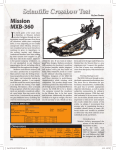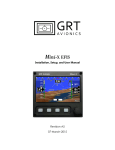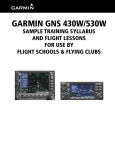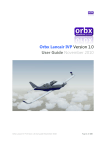Download Hail Columbia For Hot IFR
Transcript
FLIGHT TEST Hail Columbia For Hot IFR Read the numbers and compare the slicker-in-the-clag Lancair 400 to your IFR ride. We say, go for it. But retool your old IFR habits in the process. by Scott Dennstaedt onestly, I wasn’t sure about the Lancair kit plane appeal. True, the Columbia 400 isn’t a kit plane, but it was hard to dismiss the thought. Then, after flying nearly 1000 hours in Cirrus aircraft, I wasn’t convinced that the Columbia 400 was anything more than a turbocharged clone of the SR22. After completing my training to become a Lancair factory instructor however, I can wholeheartedly say that the Columbia 400 is in a class all by itself. In fact, if there’s an aircraft that clones the 400, it is the Columbia 350. Virtually identical airplanes if it weren’t for the 400’s turbocharged engine—a 310-hp Continental TSIO550C engine that sports twin turbochargers. If that doesn’t make you salivate, nothing will. While there are no turbochargers on the 350, this airplane is still an H Below: Yes, there is something other than a Cirrus: The Lancair 350 or 400. equivalent to the 400, except it has a lower price tag. Even if you’re not a high flyer, the maximum operating altitude for the 350 is still FL180. The overall vibration and noise in the cockpit of both aircraft are, as Billy Crystal would say, simply marvelous. Both use inflatable door seals to help provide a comfortable ride. I can’t explain this, but the 400 seems a tad If you buy a new “ Columbia 400, you don’t have a choice; glass is the only option. ” quieter and the ride a tad smoother than the 350. Glass And Side Sticks As a Lancair and Cirrus instructor I get asked a lot of questions about the glass cockpit. Is it reliable? Is it better than the traditional six-pack? How hard is it to transition to this new technology? Now that I have several hundred hours behind these big screen TVs, which were introduced about two years ago, it is hard to imagine flying behind anything else, especially in a high performance aircraft such as the Columbia 400. There will be a day in the future when we will look back and say, “Remember those glass cockpits we used to think were so slick?” Well, we don’t have to worry about that level of nostalgia for some time, but, just when you think that you have finally mastered a partial panel approach, companies like Lancair and Cirrus throw glass panels at you and change all the rules. Let’s just say that designated pilot examiners are having a difficult time figuring out how to simulate instrument failures in these technically advanced aircraft. If you buy a new Columbia 400, you don’t have a choice; glass is the only option. The Avidyne FlightMax Entegra primary flight display (PFD) and FlightMax EX5000C multi-function display (MFD) are standard equipment. Along with dual Garmin GNS 430s and an S-tec 55X autopilot. The art of flying has evolved into the science of buttonology and that means that you have four moving map displays in the cockpit: One on each Garmin 430, one on the MFD, and one on the moving map display underlay on the PFD’s HSI. Five, if you count your portable GPS. Avidyne has done a superb job integrating these elements. The Garmin 430s are by far the most complex component in the group—and there’s always room to learn some new trick with these units. However, the PFD with eight buttons and two knobs is intuitive and there are no deeply nested menus or complicated data entry required. That doesn’t mean there aren’t any tricks to learn, however. The Columbia 400 utilizes a side December 2004 • IFR 1 stick to control pitch and roll. “How’s flying with that side stick?” is another question I get asked by curious pilots while parked on the transient ramp. My usual answer is that it takes about 13.4 seconds to feel comfortable with it. It is really difficult to write an article about the Columbia 400 without comparing it to the Cirrus SR22. Even though they both utilize a side stick, in my opinion the 400 controls provide a smoother and more intuitive command authority without being overly sensitive. If I had to compare the two control systems, control movements in the Cirrus operate much like a traditional yoke system—pull back or push forward to change pitch and turn the stick left or right to bank. On the other hand, Lancair went with a control that is more representative of a stick, except that it is mounted on the side and not between your knees. Pop-up Drag I used to own a Turbo Arrow IV and dropping the gear after my IFR descent got me very close to my favored approach speed. However, in a slippery airplane like the Columbia 400 with the gear already welded in the down position, slowing it down quickly can be a challenge. Without getting into the shock-cooling argument, chopping the power isn’t always the best method to slow down. Speed brakes on the 400 give you the option of slowing down at any airspeed below VNE without the need for a huge power reduction. Consider the case where you’re level at FL230 and ATC issues a clearance like this: “Columbia Two Three Bravo, cross Gordonsville VOR at and maintain one one thousand...altimeter two niner eight seven.” You look down at one of your two Garmin 430s and determine that this requires a vertical descent rate of nearly 1400 feet/minute. No problem; flip the switch to deploy the Precise Flight speed brake system and ease back on the throttle a bit. You can now descend comfortably to the required 2 IFR • December 2004 altitude, keeping the engine warm without gaining excessive speed in the descent. I know you’ve heard the ATC request to keep your speed up when flying into a busy airport. This is yet another example of when it’s nice to have speed brakes. Fly the instrument or visual approach at the higher airspeed and when appropriate, deploy the speed brakes and in a matter of seconds you’re at your normal approach speed. Some pilots boast that speed brakes exist to make up for a pilot’s poor planning or air traffic control blunders. While this may be true in some instances, I claim that speed brakes should be part of your routine instrument flying. O2 For Four Since the Columbia 400 is certified up to FL250, oxygen is a must. Currently, the Columbia 400 is limited to 18,000 feet while Lancair finishes the certification process to the final limitation of 25,000 feet. The four-place built-in oxygen system option provides a clean approach to an already busy cockpit. The Columbia 400 is not pressurized so FAR 61.31 (g) (“Additional Training required for operating pressurized aircraft capable of operating at higher altitudes.”) does not apply. Flight level 250 is however, a harsh and deadly environment. If you plan to spend time in the flight levels in this airplane you should seriously consider physiological training including time Above: You are here. Or at least that’s our dream, and the Lancair reflects the reality of intuitive, glass panel nav. in an altitude chamber. It really is necessary to understand how the lack of oxygen affects your body. Control In The Stall At both the forward and aft CG limit, the Columbia 400 is amazingly docile. You can certainly tell that Lancair worked hard to make this airplane spin-resistant. With the stall horn blaring during a power-off turning stall at 17,500 feet, you typically run out of elevator before you completely stall the wing. Even in this descending configuration, the ailerons are still quite effective. This is fine at 17,500 feet. However, in a forward CG scenario during landing, it is extremely hard to overdo the flare in this airplane. You’ll typically run out of elevator just as you’re touching down. Like the Cirrus SR22, the landing picture is flat with little apparent flare necessary. The key to a gentle landing is to carry power all the way to touchdown. Lots Of Range With 98 gallons of usable fuel, the range of this airplane is phenomenal. At 12,000 feet and 65 percent power, the range is nearly 900 miles before you begin to eat away the 45-minute reserve. to power all of the systems on the affected buss. Moreover, there’s no need to start turning off equipment to shed the current load. Well, that’s not exactly true; you should at least tell the kids in the back seat to shut off their DVD player. Flight Director Above: The 400 lacks manual trim but, instead, sports a trim system (top) that almost looks too simple. Masters, cross-tie, starter, and primer are logically clustered (bottom). It all makes for manageable IFR ops. Including all the extras such as dual high-capacity alternators, twin turbochargers, four-place oxygen, speed brakes, and large fuel tanks, the basic empty weight is 2500 pounds with a maximum gross weight of 3600 pounds. While a full fuel payload of 500 pounds isn’t all that impressive, it does provide a great deal of flexibility for the pilot. Backup Sparks Lancair made many good choices when designing this airplane. In addition to the twin turbochargers, the airplane has dual batteries and dual 60-amp alternators. In an all-electric instrument aircraft, continuous power is paramount. If one of the alternators goes offline, you simply isolate the faulty alternator and hit the cross-tie switch. This allows the remaining alternator I get goose bumps when I hear the words, flight director. I can’t imagine a technically advanced aircraft without one. I don’t know why Cirrus opted not to incorporate a flight director into their instantiation of the Avidyne PFD. Fortunately, Lancair didn’t have the same vision. The autopilot master switch allows you to select between having the flight director activated or not. Therefore, if you’re really into punishment and don’t care for flight directors, you can easily switch it off, but retain the ability to use the autopilot. Even though there’s no go-around button on the stick, a flight director makes a hand flown ILS a snap. The 400 On Approach A technically advanced aircraft is not, by definition, an easy-to-fly aircraft. You’ve got to have a little bit of technogeek inside you to fully appreciate the possibilities. This is especially true when flying an instrument approach. Sure you can always brute-force a sloppy approach. But wouldn’t it be nice if you could just sit back and watch? You’d think with all the electronics in the 400, the airplane should basically fly itself all the way to the DA or MDA. To some degree this is true. The only things that must be managed manually are the throttle (with mixture and prop control) and the flaps. How hard can that be? Two of the mistakes I routinely see pilots make are flying the approach way too fast and forgetting to extend any flaps on the approach. They’re a bit overwhelmed programming the avionics and forget all about the easy stuff they have to do manually. One nice thing about the Columbia 400 is that the flaps are slow to extend. Even during a faster approach, extending flaps doesn’t cause any noticeable ballooning. I always make it a habit to extend the first notch of flaps (12 degrees) one mile prior to the final approach fix, and I don’t extend the second notch of flaps (40 degrees) until the runway environment is in sight or I’m ready to turn final from a circling approach. Engine Monitoring Whether you like flying lean of peak or rich of peak, having a complete engine and fuel monitoring system is a benefit on those IFR journeys. Heat and pressure destroy engines. Avidyne’s EMax engine and fuel monitoring system option gives you the ability to monitor each cylinder’s head and exhaust gas temperature as well as the turbine inlet temperature of the left turbocharger. There is a lean assist function that lets you get to your best economy or best power settings. Fuel monitoring is also available for keeping watch on fuel flow and managing those longerthan-average flights. Dear Santa… My wish list is very long with this airplane, but there are a few items I’d like to see added; a few of these are already in progress. Except for pitot heat, the Columbia 400 does not have any kind of antiice protection option. With an aircraft that will be certified to FL250, an antiice system is a must. Lancair is working on a non-certified anti-ice system as we speak. They’ll be replacing one of their current alternators with a super-dee-dooper alternator capable of handling the electric heated wing system. While this technology is not as effective as the weeping wing TKS anti-ice option found on the Cirrus December 2004 • IFR 3 SR22, when used properly it will be a good addition for inadvertent icing encounters. I’m still a fan of manual pitch trim, which is missing from the Columbia 400. For hand-flying the airplane it’s nice to have the ability to fine-tune the trim down to a gnat’s eyelash despite the fact that most 400 operators will be using the autopilot for 98 percent of their flight. On the other hand, the electric trim system is actually impressive. It has a set of little lights lined up in a cross on the panel that change color to indicate an in or out of trim scenario for both pitch and aileron trim. Lancair currently offers the Garmin GTX 330 Mode S transponder as an upgrade option. The Mode S datalink provides the pilot with traffic alerts (referred to as TIS) as long as the flight is within 55 nautical miles of a Mode S radar site. In my neck of the woods in the Mid-Atlantic, having a Garmin 330 is sufficient. Even though the FAA has plans to extend the range of Mode S coverage for the existing radars, there are not enough Mode S radars installed around the country as yet, leaving large gaps in between busy terminal areas. With a fast moving and high-flying aircraft such as the Columbia 400, a Ryan 9900BX TAS or Goodrich Skywatch TAS should be an option for those pilots that fly in areas not yet covered by Mode S radar. Don’t despair; it is my understanding that Lancair is in the process of certifying the Ryan 9900B (passive) and Ryan 9900BX (active) TAS for the Columbia 400. Even with all the redundant systems in this airplane, Lancair left out a very important backup instrument: they do not provide a secondary VOR head in the event of PFD failure. If the PFD were to fail, you lose your capability to fly an ILS, VOR or localizer approach. This means that you are essentially committed to a non-precision GPS or RNAV approach preferably with direct routing. Does the loss of the PFD constitute an emergency? Certainly you should 4 IFR • December 2004 exit IMC as soon as practicable. Consequently, a pilot should avoid widespread low IFR because of this shortcoming. Lancair’s choice of installing the PFD and MFD in portrait mode leaves a lot of space on the panel to add this element along with their three backup steam gauges. Stormscope And Weather I didn’t include a Stormscope and uplinked weather gear in my wish list since Lancair did make some attempt to provide these options. Interference with the alternator has caused them to discontinue this option for now. Weather in the 400 is still courtesy of the Orbcomm solution. Owners have complained that this solution doesn’t consistently provide the weather. Although with the announcement of Avidyne’s XM satellite radio weather solution, it remains to be seen if Lancair will switch over to this as an option. Training Considerations You should allow at least three full days of combined ground and flight training to become acquainted with this technically advanced aircraft. How much training you’ll need following this initial familiarization depends largely on the amount of experience you have with high performance aircraft and all the fancy avionics. I cannot emphasize enough that stick and rudder skills are only a small portion of learning to fly this aircraft. In the instrument world it is critical that you feel comfortable integrating the PFD, GPSs and autopilot. As you know, the cockpit can get busy during the departure and arrival phases of an instrument flight. Everything happens a bit faster and staying ahead of the airplane is testament to being proficient. Find a qualified CFII that knows the airplane and the avionics and train often. Lots Of Orders Okay, the good news is that Lancair has plenty of future business to keep the company strong. The bad news is that this popularity has placed 120 planes on backorder as of this writing. In the spring of 2005, they will stop producing 400s and will transition the line to building Columbia 350s, which means that if you place your order now for a Columbia 400, it may be almost a year or longer before you get your airplane. In my opinion, this airplane is worth the wait. Scott Dennstaedt is an IFR contributing editor and a nationwide Lancair factory instructor. You can contact him at [email protected]. You’re A What? It’s pronounced, Lance-air not Langk-air, which sounds like a Finnish charter service. Either way, ATC may not know what to make of you when you check on the frequency requesting flight levels. Some controllers might insist that you’re a homebuilt and will preface your callsign with “Experimental.” Whatever name you’re called don’t be offended, just be prepared to educate. When approach control sounds confused about your pedigree—“What’s a Lancair?”— quickly give the essentials: “It’s a single-engine, piston, that’ll hold 150 knots to the marker, and can make the first turnoff.” A bit of an exaggeration, perhaps, but it gives the controller a clearer picture of your ability if not your charms. All certificated aircraft should be in the ATC handbook (7110.65) Appendix A, listing category and general performance, but there’s a good chance your controller won’t know the odd ball stuff. The controller wants to know performance— how fast can you go and can you use the short runway? Later you can preen about how cool you look when you park beside the tower.
















